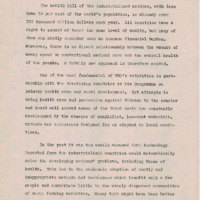APPROPRIATE TECHNOLOGY EOR HEALTH
Item
- Title
- APPROPRIATE TECHNOLOGY EOR HEALTH
- extracted text
-
SDA-RF-AT-3.17
APPROPRIATE TECHNOLOGY EOR HEALTH.
The health bill of the industrialized nations, with less
than 30 per cent of the world’s population, is already over
300 thousand million dollars each year.
All countries have a
right to expect at least the same level of health, but many of
them can hardly shoulder such an immense financial burden.
Moreover, there is no direct relationship between the amount of
money spent on conventional .medical care and the overall health
of the people.
A totally new approach is therefore needed.
One of the most fundamental of WHO’s activities in part
nership with the developing countries is its programme on
primary health care and rural development.
Yet attempts to
bring health care and protection against disease to the remoter
and least well served areas of the Third World are constantly
handicapped by the absence of simplified, low-cost materials,
methods and techniques designed for or adapted to local condi
tions.
In the past it was too easily assumed that technology
imported from the industrialized countries would automatically
solve the developing nations’ problems, including those of
health.
This led to the wholesale adoption of costly and
inappropriate methods and techniques which benefit only a few
people and contribute little to the widely dispersed communities
of rural farming societies.
Money that might have been better
spent has been squandered on such efforts and, in the process,
the developing health services have become unduly dependent on
the advanced industry of the developed world.
Indeed many
2
industrialized countries are now beginning to reassess the
appropriateness of their own technologies.
The right tools for the job
A resolution adopted by WHO’s Member States at the World
Health Assembly in May I976 stressed that primary health care
and health technology must go hand in hand.
As a direct result,
WO has now embarked on a new programme entitled "Appropriate
Technology for Health".
Its objective is to help national
governments solve the problems encountered in primary health
care programmes (particularly those problems aggraved by the
lack of an appropriate technology), at the same time both
reducing the current dependence on imported technology and
incieasing uhe effectiveness of national health services.
Why "appropriate" technology?
Because the kind of
technology the programme is searching for must be right not
only for the particular problem but also for each individual
country’s situation.
It must be scientifically sound and
operationally effective — in some cases advanced scientific
skills will be necessary for its initial development.
But it
must also be acceptable both to the decision-makers and to the
communities it serves; it must be tailored to the existing
local financial, technical and manpower resources, and it must
recognise local cultural constraints.
The targets
Drawing on skills, knowledge and creativity from many
disciplines, the programme will concentrate on health care
3
proolems wnich a suitable technology might help to solve.
Sometimes an effective solution already exists, but is either
little knovzn or unacceptable; or it has been found, but needs
to be improved.
When there is no known solution 9 a new
technique has to be sought out and tested.
The search will focus both on methods and materials equipment, tools, devices, chemicals, drugs, biological
substances - and as how to use them to best effect,
is only part of the story.
But this
The technical difficulties
confronting a health project are often aggravated by operational,
financial or cultural constraints.
So the WHO programme will
also deal with ways of encouraging people to accept new tech
nologies, training staff for their use and maintenance, and
the proper production, distribution and application of
inscruments and materials in the countries where they are
needed.
Further steps will be; in collaboration with the
countries concerned to build up a list of health care problems;
to make a census-of appropriate technology already in use that
could be applied in other countries; and to draw up an
inventory of institutions, groups and individuals throughout
the world with a special interest in appropriate technology
for the health sector.
An essential element will be a system
for collecting information on existing and new technologies
and making it available to those whose needs are greatest;
namely those who face the actual problems in the field.
4
Once a .list of priority needs has been worked out,
research and development contracts will be negotiated with
appropriate technology groups in various parts of the world.
The intention is to begin work as soon as possible on some
of the technological problems already identified and to start
field trials in one or two countries.
In all these activities,
TOO is assuming a coordinating role.
Challenge for the future
A great deal is already happening all over the world
today in the field of appropriate technology,
Those activities
which are potentially of value to the health sector need to
be identified and coordinated.
The success of the new
programme will depend on the readiness of countries to commit
themselves to its aims and challenges.
Many still have to be
convinced that locally produced , low-cost, simple technologies
are not auxomatically second-rate. In fact to develop
appropriate technologies in the developing world calls for
much more ingenuity than is generally believed.
Health
professionals in all countries must be prepared to modify
present conventional attitudes and accept alternative ways as
well as some traditional practices of proven value.
Because the now programme reaches beyond the usual
boundaries of the health sector, it has been planned from the
start as a collaborative effort with all those age ncio s,
institutions and individuals concerned in the development of
A
5
national resources.
It provides an unpreeedent opportunity for the
developed and developing world to work in partnership
for the benefit of all.
- Media
 SDA-RF-AT-3.17.pdf
SDA-RF-AT-3.17.pdf
Position: 3806 (2 views)
